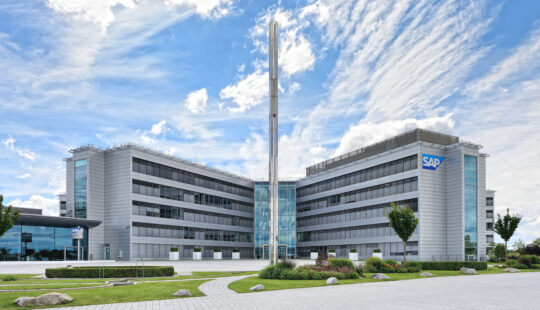October 3, 2020, marks the 30th anniversary of German reunification. Among the challenges East Germany faced three decades ago was making the transition from a planned to a social market economy. SAP played its part here, showing true pioneering spirit.
When the Berlin Wall fell on November 9, 1989, SAP Co-Founders Hasso Plattner, Klaus Tschira, and Hans-Werner Hector were sitting in a conference room in Princeton, New Jersey, at the first-ever SAPPHIRE event. They were speaking with a large gathering of customers about their requirements for SAP software. Fellow Co-Founder Dietmar Hopp was holding the fort back at company headquarters in Walldorf, Germany.
The momentous events in Berlin signaled the start of what Germans call the Wende, which literally means “transformation” and describes the period of change that began with the fall of the Wall. It came without warning.
“None of us, even in our wildest dreams, ever thought that the Berlin Wall would come down,” says Alfred Wenzel, who was to become one of the driving forces in SAP’s expansion eastward in the months and years after the historic event.
As unexpected as this sudden “broadening of horizons” was for SAP — its workforce then numbered about 1,600 — its top managers spared no effort in seizing the opportunity to tap into new markets. In so doing, they made a significant contribution to unifying the “two Germanys” and their divergent economic systems.
SAP’s expansion in the former East Germany after reunification is an exciting chapter in the company’s history. The story, unsurprisingly, begins in Berlin.
Connecting with East and West
In early 1990, just weeks after the Wall fell, SAP was looking to make Berlin a key hub for its new business operations in eastern Germany. But the demand for housing and office space far outstripped supply. SAP was not the only company looking for premises in the city. Rents were astronomical, so SAP initially set up a base at the Grand Hotel Berlin, now the Westin Grand Berlin.
“From the hotel, you had access to the East German telephone network, and you could also stay in contact with the West,” says Wenzel, then regional manager for the Eastern European economic area. The situation required equipment and technology that was by no means standard at the time. Wenzel set up a mobile office for himself with a portable fax machine and telephone. He needed the fax machine to exchange information with the Walldorf office and to send detailed contract proposals to potential customers.
“If a customer wanted to actually sign a contract, it had to send a telex message to Walldorf,” Walter Bachmann, consulting lead at SAP’s Berlin office, recalls. “Faxes were not legally binding documents.”
Search for the Right People
Wenzel appointed the three members of his core team for SAP’s East German business in early 1990. They were Bachmann along with Peter Philipps as consulting lead for logistics and Wolf-Dietrich Seidel as head of sales.
The first task awaiting the new management team in Berlin was recruiting staff for the new office there, which in itself was a real challenge. Bachmann had experience as a manager but was unfamiliar with what applications in East Germany looked like and what they contained. And he was unsure how to interpret the grades, certificates, and qualifications awarded in the German Democratic Republic.
Thomas Harnisch and two of his colleagues from Elektro-Apparate-Werke Berlin, an East German state-owned manufacturer of electrical appliances, were among the first applicants. They had read about SAP in brochures their boss had brought back from the spring trade fair in Leipzig, Leipziger Frühjahrsmesse, in 1990.
Applications by the Bucketload
Ahead of its second hiring phase, SAP placed a large job ad in East German newspapers Neues Deutschland and Berliner Zeitung. Response was huge. Among the 2,000 or so applications SAP received was one from Heidelore Castro, now head of Practice Unit Banking EMEA. Atop her list of reasons for applying to be an SAP consultant were the company’s “international focus and its unique software solutions for financial accounting and enterprise management.”
The management team waded through “applications by the bucketload” before finally selecting 100 candidates for interview. Looking back, Bachmann recalls feeling “an amazing sense of optimism; we were very aware that behind all those applications were real people, each with their own story.”
The subsequent interview round was on a scale never before experienced at SAP. “We interviewed right through from Friday afternoon until Sunday,” says Wenzel. “And everyone helped out, including the Executive Board. It was exhausting, but the fact that Dietmar Hopp was present was a sign of just how important this process was for SAP.”
Interviews were held in Walldorf, in the offices in Max-Planck-Strasse, then known as the MPS building and now Building 8. “On arrival, we reported to reception in the MPS,” says Harnisch. “Dietmar Hopp was there to welcome us and, on seeing our smart business attire, joked that SAP had a more casual dress code.”
Ralf Michel was also one of the newbies and has happy memories of those early days. “SAP placed immense trust in us,” he says. “There was a great feeling of solidarity. It was as if we were one big family. And we really did experience what Dietmar Hopp had said he wanted for his employees — namely, that they should share in the company’s success.”
Investing in People
In April of 1990, SAP began renting an administrative office and a demo room at the Siemens subsidiary Sietec, located at Nonnendammallee 101, northwest of downtown Berlin. Initially, this location was little more than a formal address, because the new hires from East Germany spent the first six months attending back-to-back training courses in Walldorf. “We weren’t ready to start working productively from day one,” says Heidelore Castro, one of only six women among the 70 new hires. “SAP invested a great deal in us to make sure that we would go on to give customers first-class support.”
SAP lent its East German employees company cars so that they could travel to SAP headquarters for their training. “One of my colleagues drove to Walldorf in a Trabi [the iconic East German-built car]. Dietmar Hopp asked if he could take a look at it in the lunch break because he’d never seen one close up before,” Harnisch shares. The second wave of new hires and those who followed after traveled to Walldorf for training on buses provided by SAP.
SAP Raises Its Profile
The SAP congress at the International Congress Center in Berlin in September 1990 was an “absolute sensation,” according to Wenzel. Entitled, “Integrated Standard Software for Enterprise Management in the GDR,” it did wonders to raise SAP’s profile in East Germany. “This three-day event covered all aspects of business and the entire SAP portfolio, and it really focused on promoting our products.”
Hopp, Oswald, Paul Neugart, and many others were there to present SAP and its software. “All the speakers were big names and, most important of all, they were the absolute experts in their field,” Wenzel says. Hopp, then SAP CEO, made a particularly striking impression. Consulting lead Bachmann recalls: “Hopp was incredible. He had an authentic charisma that really resonated with East German managers. Which was crucial, because while many West German companies were just after East German companies’ money, Dietmar Hopp’s message was, ‘We can help you!’”
Word got around that SAP offered something East German companies urgently needed: software that would help them transition from a centrally planned to a social market economy and, above all, implement the new legal requirements in human resources and enable their companies to compete in the new market.
“Our message to them was that they were buying business expertise as well as software,” Bachmann explains.
Springboard to Eastern Europe
With 70 new hires onboard, SAP managers suddenly found themselves heading up a sizeable team. The new hires brought plenty of skills to the mix.
“Many of the colleagues recruited at that time had studied in the Soviet Union or at least spoke Russian very well,” says Harnisch. “You could see what the plan was: SAP wanted to expand into more markets, such as the Union of Soviet Socialist Republics and other Eastern Bloc countries, and to do so out of the GDR and with the help of the East German employees.”
During the hiring process, Wenzel had focused on the candidates’ suitability to work on projects in other eastern European countries, especially the USSR. “We assigned these specialists to the relevant country-version development projects at an early stage, and long before giving them international assignments. This gave them time to prove themselves and acquire the skills they needed to go on and become part of the core team for the corresponding country.” .
For their part, the new hires were happy to have a job in the turbulent times that accompanied the Wende. And they were particularly happy when the SAP office in Waldstrasse opened in early 1991, remembers Hans-Günter Heinel, who joined SAP in September 1990 with the second wave of new hires.
Measuring about 43,000 square feet, the new office was on the second floor above a DIY store and provided space for a training center. This building remained SAP’s home in Berlin in a reunified Germany for more than 10 years – right up until the move to the new offices in Rosenthaler Strasse in 2003.



